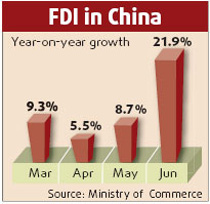China's trade surplus jumped 83 percent to $136.9 billion from January to July and its foreign exchange reserves mounted to $1.3 trillion in the first six months.
Such figures have aroused concerns not only of its trade partners, but also of those who are not sure whether policymakers can handle the increasing liquidity.
Almost all agree that excess liquidity is flooding the Chinese market, but there is no consensus how the conclusion has been drawn.
"It's very hard to estimate the excess liquidity," said Stephen Green, senior economist with Standard Chartered Bank. "The measure I like the best is M2/GDP ratio, which hit 160 percent (in China) three years ago," he said.
M2 is the broad measure of money supply, which includes all types of deposits and cash. It exceeded 3.7 trillion yuan by the end of June, according to the central bank.
By the end of last year, China's M2/GDP ratio rose to 165 percent, much higher than Japan's 143 percent and 53 percent in the United States.
Economists also use other indicators to assess the situation, such as the gap between bank deposits and lending, and the ratio of liquid assets to overall banking assets, which all point to excess liquidity in China.
The excess liquidity has come, fundamentally, from two sources: domestically, from accumulation of deposits; internationally, from inflow of capital such as the foreign exchange reserves and speculative money, according to Li Yang, director at the Institute of Finance and Banking, the Chinese Academy of Social Sciences.
China's imbalance in its investment and consumption structures has led to prolonged weak demand, which has exacerbated the pile-up of deposits, said Zhuang Jian, senior economist with the Asian Development Bank (ADB) in China.
The country's economy has been dependent on investment and exports in the past decade, not domestic demand, although the government is trying hard to increase consumption.
By the end of May, bank deposits held by the Chinese people amounted to 17.1 trillion yuan, nearly double the level five years ago.
It's a consensus that the public has preferred to save rather than spend because it anticipates long-term spending pressures from the country's restructuring of its pension, health and education systems.
China needs to raise wages and increase the provision of such public services as education and healthcare to enhance people's spending propensity, Zhuang said.
The social security network must also be improved, which will also get people more active in consumption, Zhuang said.
From a global perspective, Li from CASS said the low savings rate of developed countries has led to the trade deficit of these countries and the surpluses in Asian economies. The US has kept the dollar weak and, as a result, international markets have been awash with dollars.
Japan has seen a large-scale capital outflow to other countries. In Europe, statistics show the capital outflow is also on the rise as euro gets strong. It has also contributed to the global liquidity boom, Li said. And most of the capital has flown into Asia, including China, Li added.
On capital inflow, Li suggested the holders of China's foreign exchange should be diversified, allowing individuals and enterprises to hold more of the reserves.
Although the central bank can sterilize foreign capital through issuing bills, raising the banks' reserve requirement ratio or conducting currency swaps, they can ease the pressure only temporarily, Li said.
(China Daily September 6, 2007)


